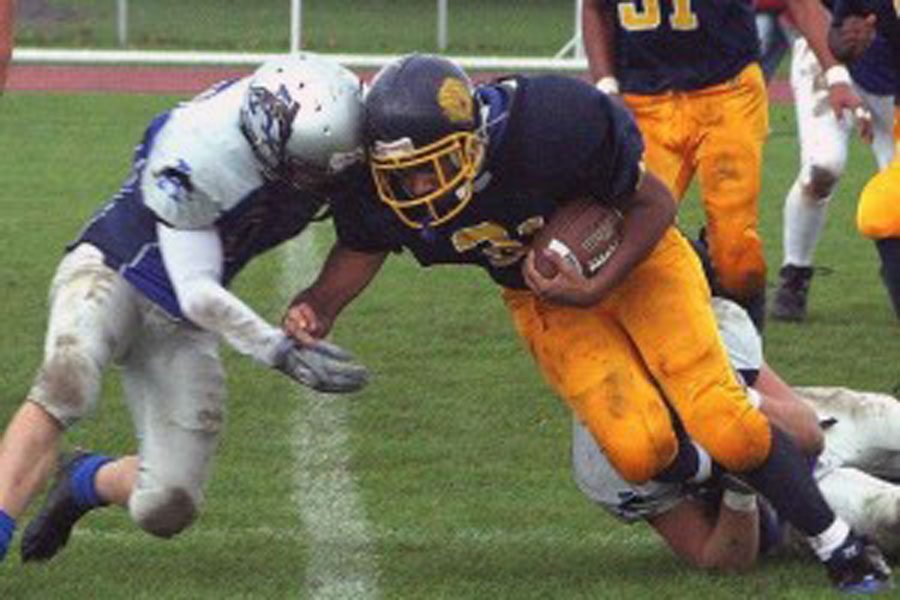CTE and How It’s Not All About Concussions
CTE has taken over as the main worry of football parents everywhere, and theirs not much the sport can do about it
January 25, 2018
In a recent study, more research has backed the idea that hits to the head in general, cause CTE, not just concussions. CTE stands for Chronic Traumatic Encephalopathy, a disease found in people with repetitive brain trauma, often athletes. CTE has actually been known about since the 1920s and has most commonly afflicted boxers. It was dubbed, “punch drunk syndrome.” As time progressed, the disease has been discovered in other types of sports, including football and hockey. The disease has been found in both current and retired players and can be developed months, years or even decades after the player has retired. The repeated brain trauma leads to the “progressive degeneration of the brain tissue” and the “build-up of an abnormal protein called tau” according to Boston University CTE Center. These changes in the brain can cause difficulty thinking, impulsive behavior, depression or apathy, short-term memory loss, difficulty planning and carrying out tasks, emotional instability, substance abuse or even suicidal thoughts or behavior.
These are definitely major symptoms, and some people now think it’s too big of a risk to play these contact sports or have there kids play them. New research even suggests that CTE can reduce life expectancy. The fact that CTE is produced from contact in general, there’s not a lot the sports can do as they revolve around contact. The National Football League has admitted that football definitely is a link with the disease. Recent studies from Boston College have shown the disease in 90 of 94 brains of deceased NFL players, as the disease can only be identified after the player dies. They also found it 45 of 55 college players, and 6 of 16 high school players. “We learn more from our own experience and we have made great progress. We continue to make rule changes to our game to make the game safer and protect our players from unnecessary injury, from acts that we see can lead to increased probability of an injury, says NFL commissioner Roger Goodell.
Former football players have suffered from the effects of CTE, including it taking their lives in the form of suicide. Former NFL player Junior Seau died on May 2nd, 2012, from a self, inflicted gunshot wound to the chest. His family donated Seau’s brain tissue to the National Institute Of Neurological Disorders And Stroke, and on January 10th, 2013, Seau’s family released the National Institute Of Neurological Disorders And Stroke findings and they showed “definitive signs of CTE.” Seau is not the only football player to commit suicide due to CTE, Ohio State University player Kosta Karageorge, committed suicide after leaving his mother a note saying “Football Has My Head All Messed Up.” Other players like Dave Duerson, a safety who played 10 years for the Bears, Giants, and Cardinals, requested in his suicide note that his brain is used for research, as it was the reason he ended his own life.
Bennet Omalu, one of the doctors who had brought the idea of CTE to the public, estimates that over 90 percent of current NFL players have CTE.“They could have maybe minimal symptoms, mild symptoms, moderate symptoms, or severe symptoms. I meet with retired football players. Some are well-dressed, some are well-spoken, but when you talk to them personally they will admit to you that they are having problems. But they are managing their problems. They have impaired memory, they’re having mood problems. They are being treated by their psychiatrists. So I think 90 to 100% of all of them will have some residual problem from their exposure to thousands of blows to the head.”
Dr. Lee Goldstein, lead author of the study and associate professor at Boston University School of Medicine and College of Engineering says that kids under 14 should be refrained from playing tackle football, as this is the key time of their brains developing. “In an ideal world, tackle football would be pushed back until later in adolescence”, Goldstein says — “your brain continues to develop into your twenties” — but he knows such restrictions are unrealistic, given how deeply high school and college football is ingrained in American culture. “We prohibit children from engaging in dangerous behaviors, like driving and drinking,” says Goldstein. “Maybe we need to think about whether or not we want to expose our own kids to something that can be inducing lifelong harm, and accelerating a neurodegenerative disease.”
All in all, CTE has taken a major toll on the lives of athletes everywhere, and definitely presents a problem for contact sports like football.


